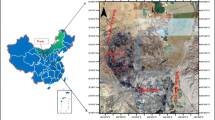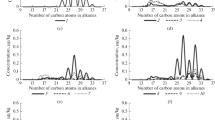Abstract
Natural chloroform in soil gas below four coniferous forest sites was studied. High concentrations were found within narrow areas—Hot Spots—varying from ~25 to >400 m2 in size, with chloroform concentrations being typically 20–100 times those in corresponding Low Spots.Attempts to localize Hot Spots by visual inspection with regard to type and density of vegetation failed. Possible differences between Hot and Low Spots could be emission, leaching or degradation of chloroform. However, emissions of chloroform from Hot Spots were ~10 times higher than from Low Spots and similarly the chloroform concentration in groundwater below a Hot Spot was ~10 times higher than below the corresponding Low Spot. No differences in chloroform mineralization rates were observed between sites and incubation of soil cores confirmed a larger net formation of chloroform in the Hot Spots. Various soil parameters were measured in order to compare the soil sampled from Hot and Low Spots. The halogenation degree of organic soil samples was in the same range, although slightly higher in the H-horizon of the Hot Spot. The chloroform formation potential of the soil organic matter showed differences between soil horizons but not between sites. The high levels of chloroform in the Hot Spots are probably best explained by differences in chloroform forming activity caused by an uneven distribution of yet unidentified microorganisms, since differences in soil organic matter quality and in emission, leaching and degradation of chloroform as well as a number of additional soil parameters could be completely ruled out.








Similar content being viewed by others
References
Albers CN, Laier T, Jacobsen OS (2008) Vertical and horizontal variation in natural chloroform in two adjacent soil profiles in a coniferous forest. In: Mander U, Brebbia CA, Martin-Duque JF (eds) Geo-environment and landscape evolution III, Proceedings of the third international conference on evolution, monitoring, simulation, management and remediation of the geological environment and landscape, Southampton, 2008. WIT Press, Southampton, pp 161–170
Albers CN, Laier T, Jacobsen OS (Submitted) Formation, fate and leaching of chloroform below coniferous forests. Appl Geochem
Alvarez-Cohen L, McCarty PL, Boulygina E, Hanson RS, Brusseau GA, Tsien HC (1992) Characterization of methane-utilizing bacterium from a bacterial consortium that rapidly degrades trichloroethylene and chloroform. Appl Environ Microbiol 58:1886–1893
Asplund G, Grimvall A (1991) Organohalogens in nature—more widespread than previously assumed. Environ Sci Technol 25:1346–1350
Asplund G, Grimvall A, Petterson C (1989) Naturally produced adsorbable organic halogens (AOX) in humic substances from soil and water. Sci Tot Environ 81(82):239–248
Asplund G, Christiansen JV, Grimvall A (1993) A chloroperoxidase-like catalyst in soil: detection and characterization of some properties. Soil Biol Biochem 25:41–46
Asplund G, Grimvall A, Jonsson S (1994) Determination of the total and leachable amounts of organohalogens in soil. Chemosphere 28:1467–1475
Bartnicki EW, Castro CE (1994) Biodehalogenation: rapid oxidative metabolism of mono and polyhalomethanes by Methylosinus Trichosporium OB-3b. Environ Toxicol Chem 13:241–245
Boyce SD, Hornig JF (1983) Reaction pathways of trihalomethane formation from the halogenation of dihydroxyaromatic compounds for humic acid. Environ Sci Technol 17:202–211
Busenberg E, Plummer LN (1992) Use of chlorofluorocarbons (CCl3F and CCl2F2) as hydrologic tracers and age-dating tools: the alluvium and terrace system of central Oklahoma. Water Resour Res 28:2257–2283
Chang H-L, Alvarez-Cohen L (1996) Biodegradation of individual and multiple chlorinated aliphatic hydrocarbons by methane-oxidizing cultures. Appl Environ Microbiol 62:3371–3377
Deborde M, von Gunten U (2008) Reactions of chlorine with inorganic and organic compounds during water treatment: kinetics and mechanisms. A critical review. Water Res 42:13–51
Dimmer CH, Simmonds PG, Nickless G, Bassford MR (2001) Biogenic fluxes of halomethanes from Irish peatland ecosystems. Atmos Environ 35:321–330
Field JA, Verhagen FJM, Mester T, Swarts HJ, Wijnberg JBPA, de Jong E (1997) Organohalogen metabolites of Basidiomycetes. In: Janssen DB, Soda K, Wever R (eds) Mechanisms of biohalogenation and dehalogenation,Tweede Reeks, deel 98. Koninklijke Nederlandse Akademie van Wetenschappen Verhandelingen, Afd. Natuurkunde, Amsterdam, pp 33–42
Flores EMM, Barin JS, Mesko MF, Knapp G (2007) Sample preparation techniques based on combustion reactions in closed vessels—a brief overview and recent applications. Spectrochim Acta B 62:1051–1064
Flores EMM, Mesko MF, Moraes DP, Pereira JSF, Mello PA, Barin JS, Knapp G (2008) Determination of halogens in coal after digestion using the microwave induced combustion technique. Anal Chem 80:1865–1870
Frank W, Frank H (1990) Concentrations of airborne C1- and C2-halocarbons in forest areas in West Germany: results of three campaigns in 1986, 1987 and 1988. Atmos Environ 24A:1735–1739
Frank H, Frank W, Thiel D (1989) C1- and C2-halocarbons in soil-air of forests. Atmos Environ 23:1333–1335
Hamilton JTG, McRoberts WC, Keppler F, Kalin RB, Harper DB (2003) Chloride methylation by plant pectin: an efficient environmentally significant process. Science 301:206–209
Harper DB, Kennedy JT, Hamilton JTG (1988) Chloromethane biosynthesis in poroid fungi. Phytochemistry 27:3147–3153
Haselmann KF, Ketola RA, Laturnus F, Lauritsen FR, Grøn C (2000) Occurrence and formation of chloroform at Danish forest sites. Atmos Environ 34:187–193
Haselmann KF, Laturnus F, Grøn C (2002) Formation of chloroform in soil. A year-round study at a Danish spruce forest site. Water Air Soil Pollut 139:35–41
Hellén H, Hakola H, Pystynen K-H, Rinne J, Haapanala S (2006) C2–C10 hydrocarbon emissions from boreal wetland and forest floor. Biogeosciences 3:167–174
Hjelm O, Johansson M-B, Öberg-Asplund G (1995) Organically bound halogens in coniferous forest soil—distribution pattern and evidence of in situ production. Chemosphere 30:2353–2364
Hjelm O, Johansson E, Öberg G (1999) Production of organically bound halogens by the litter-degrading fungus Lepista nuda. Soil Biol Biochem 31:1509–1515
Hoekstra EJ, De Leer EWB, Brinkman UAT (1998a) Natural formation of chloroform and brominated trihalomethanes in soil. Environ Sci Technol 32:3724–3729
Hoekstra EJ, Verhagen FJM, Field JA, De Leer EWB, Brinkman UAT (1998b) Natural production of chloroform by fungi. Phytochemistry 49:91–97
Hoekstra EJ, Duyzer JH, De Leer EWB, Brinkman AT (2001) Chloroform—concentration gradients in soil air and atmospheric air, and emission fluxes from soil. Atmos Environ 35:61–70
Huber SG, Kotte K, Schöler HF, Williams J (2009) Natural abiotic formation of trihalomethanes in soil: result from laboratory studies and field samples. Environ Sci Technol 43:4934–4939
Jacobsen OS, Laier T, Juhler RK, Kristiansen SM, Dichmann E, Brinck K, Juhl MM, Grøn C (2007) Forekomst og naturlig production af chloroform i grundvand (In Danish, English Summary). Miljøministeriet (Danish Environmental Protection Agency)
Johansson E, Ebenå G, Sandén P, Svensson T, Öberg G (2001) Organic and inorganic chlorine in Swedish spruce forest soil: influence of nitrogen. Geoderma 101:1–13
Johnsen AR, Jacobsen OS (2008) A quick and sensitive method for the quantification of peroxidase activity of organic surface soil from forests. Soil Biol Biochem 40:814–821
Kenneke JF, Weber EJ (2003) Reductive dehalogenation of halomethanes in iron and sulphate-reducing sediments. 1. Reactivity pattern analysis. Environ Sci Technol 37:713–720
Keppler F, Harper DB, Röckmann T, Moore RM, Hamilton JTG (2005) New insight into the atmospheric chloromethane budget gained using stable carbon isotope ratios. Atmos Chem Phys 5:2403–2411
Laturnus F, Mehrtens G, Grøn C (1995) Haloperoxidase-like activity in spruce forest soil—a source of volatile halogenated organic compounds. Chemosphere 31:3709–3719
Laturnus F, Lauritsen FR, Grøn C (2000) Chloroform in a pristine aquifer system: toward an evidence of biogenic origin. Water Resour Res 36:2999–3009
Laturnus F, Haselmann KF, Borch T, Grøn C (2002) Terrestrial natural sources of trichloromethane (chloroform, CHCl3)—an overview. Biogeochemistry 60:121–139
Maw GA, Kempton RJ (1982) Bromine in soils and peats. Plant Soil 65:103–109
McCulloch A (2003) Chloroform in the environment: occurrence, sources, sinks and effects. Chemosphere 50:1291–1308
Moraes DP, Mesko MF, Mello PA, Paniz JNG, Dressler VL, Knapp G, Flores EMM (2007) Application of microwave induced combustion in closed vessels for carbon black-containing elastomers decomposition. Spectrochim Acta B 62:1065–1071
Moss ML, Mellon MG (1942) Colorimetric determination of iron with 2,2-bipyridyl and with 2,2,2-terpyridyl. Ind Eng Chem Anal 14:862–865
NOAA (2009) Database of advanced global atmospheric gases experiment. http://agage.eas.gatech.edu/data.htm. Cited 10 Dec 2009
Öberg G, Grøn C (1998) Sources of organic halogens in spruce forest soil. Environ Sci Technol 32:1573–1579
Öberg G, Börjesson I, Samuelsson B (1996) Net change in organically bound halogens in relation to soil pH. Water Air Soil Pollut 89:351–361
Öberg G, Brunberg H, Hjelm O (1997) Production of organically-bound chlorine during degradation of birch wood by common white-rot fungi. Soil Biol Biochem 29:191–197
Osono T (2007) Ecology of ligninolytic fungi associated with leaf litter decomposition. Ecol Res 22:955–974
Reckhow DA, Singer PC, Malcolm RL (1990) Chlorination of humic materials: byproduct formation and chemical interpretations. Environ Sci Technol 24:1655–1664
Rhew RC, Miller BR, Weiss RF (2008) Chloroform, carbon tetrachloride and methyl chloroform fluxes in southern California ecosystems. Atmos Environ 42:7135–7140
Rook JJ (1977) Chlorination reactions of fulvic acids in natural waters. Environ Sci Technol 11:478–482
Ryall DB, Derwent RG, Manning AJ, Simmonds PG, O′Doherty S (2001) Estimating source regions of European emissions of trace gases from observations at Mace Head. Atmos Environ 35:2507–2523
Sheng D, Gold MH (1997) Haloperoxidase activity of Manganese peroxidase from Phanerochaete chrysosporium. Arch Biochem Biophys 345:126–134
Silk PJ, Lonergan GC, Arenault TL, Boyle CD (1997) Evidence of natural organochlorine formation in peat bogs. Chemosphere 35:2865–2880
Snajdr J, Valásková V, Mrhautová V, Herinková J, Cajthaml T, Baldrian P (2008) Spatial variability of enzyme activities and microbial biomass in the upper layers of Quercus petraea forest soil. Soil Biol Biochem 40:2068–2075
Squillace PJ, Moran MJ, Lapham WW, Price CV, Clawges RM, Zogorski JS (1999) Volatile organic compounds in untreated ambient groundwater, 1985–1995. Environ Sci Technol 33:4176–4187
Squillace PJ, Moran MJ, Price CV (2004) VOCs in shallow groundwater in new residential/commercial areas of the United States. Environ Sci Technol 38:5327–5338
Strand SE, Shippert L (1986) Oxidation of chloroform in an aerobic soil exposed to natural gas. Appl Environ Microbiol 52:203–205
Svensson T, Laturnus F, Sandén P, Öberg G (2007) Chloroform in runoff water—a two year study in a small catchment in Southeast Sweden. Biogeochemistry 82:139–151
Vollenbroek EGM, Simons LH, van Schijndel JWPM, Barnett P, Balzar M, Dekker H, van der Linden C, Wever R (1995) Vanadium chloroperoxidases occur widely in nature. Biochem Soc Trans 23:267–271
Worton DR, Sturges WT, Schwander J, Mulvaney R, Barnola J-M, Chapellaz J (2006) 20th century trends and budget implications of chloroform related tri- and dihalomethanes inferred from firn air. Atmos Chem Phys 6:2847–2863
Acknowledgments
Anders Risbjerg Johnsen is thanked for valuable comments to the preparation of the manuscript. This study was financially supported by grant no. 09-061119/FTP of The Danish Agency for Science, Technology and Innovation (C. N. Albers).
Author information
Authors and Affiliations
Corresponding author
Electronic supplementary material
Below is the link to the electronic supplementary material.
Rights and permissions
About this article
Cite this article
Albers, C.N., Jacobsen, O.S., Flores, É.M.M. et al. Spatial variation in natural formation of chloroform in the soils of four coniferous forests. Biogeochemistry 103, 317–334 (2011). https://doi.org/10.1007/s10533-010-9467-9
Received:
Accepted:
Published:
Issue Date:
DOI: https://doi.org/10.1007/s10533-010-9467-9




